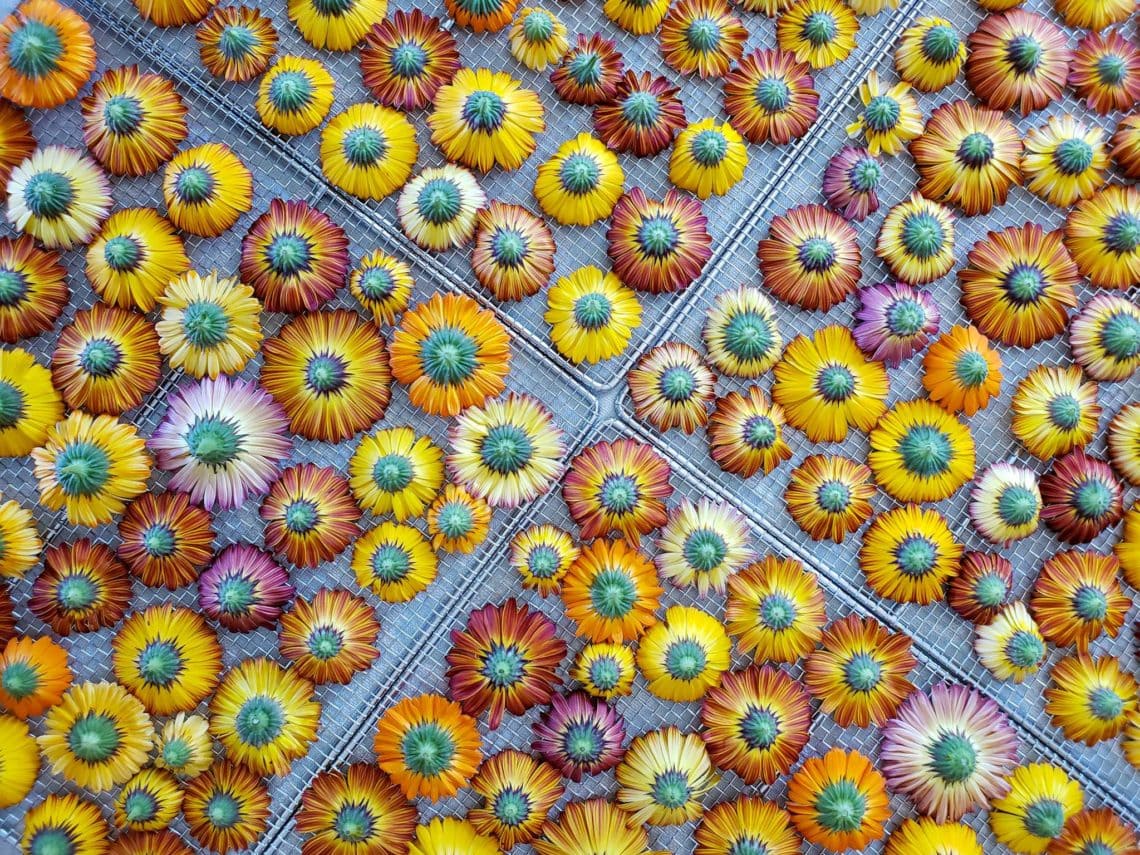
All About Calendula: How to Grow, Harvest, Dry, & Use Calendula Flowers
Calendula officinalis just may be one of my favorite annual flowers to grow in the garden. Yes, I could probably say that about many flowers – I do love them all! – but calendula definitely deserves to be among the top 5. It is gorgeous, easy to grow, has a long blooming season, and is super easy to save seeds from. Additionally, did you know that calendula is both medicinal and edible? It sure is!
Come read along to learn how to grow calendula along with it various benefits and how to harvest, dry, and use it. In addition to providing a burst of sunshine in the garden, you may be surprised to learn what expansive natural healing properties it has!
Get to Know Calendula
Calendula is highly prized by gardeners and herbalist alike due to the versatility of this flower. To be more accurate, we should call calendula by what it really is: a flowering herb! Note that calendula is sometimes referred to as “pot marigold” – but don’t confuse it with true marigolds, such as french marigolds. They’re distinctly different, and not nearly as medicinal in nature.
Sprinkle fresh or dried calendula blossom petals on top of salads (or any dish really) as a cheerful pop of color! They also make a beautiful and tasty addition to scrambled eggs, frittata, summer salsa, or even in soup! Whole dried flowers can also be added to soups, broths, and stews in the winter for an extra immunity boost. Or, put some pep in your summer beverages with a calendula garnish.
Another bonus is that calendula makes an excellent companion plant in any vegetable or pollinator-friendly garden! It is #1 on our list of Top 23 Plants for Pollinators. This flower attracts bees and butterflies, and is said to repel pest insects. Its roots may help increase the activity of beneficial microbes and fungi in the soil.
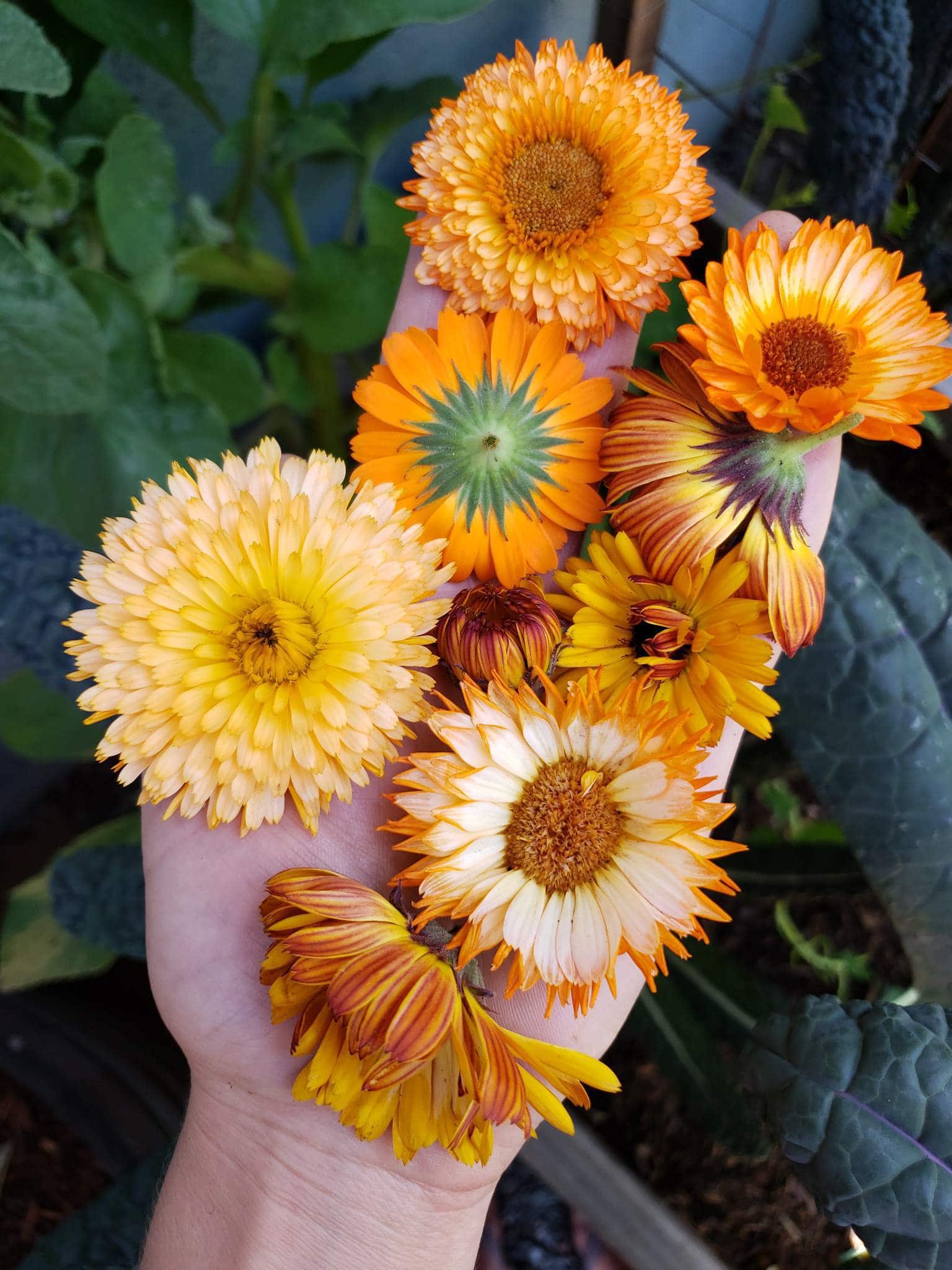
Medicinal Benefits of Calendula
Calendula has been called upon for centuries to treat skin ailments, support the immune system, and heal infections, both internally and externally. If you pay attention to labels, you’ll probably notice calendula as a key ingredient in many natural skin care products, and for a good reason! We primarily grow calendula to make soothing skin salves.
Topically, calendula can ease, heal, or otherwise treat a huge array of skin conditions. According to the Chestnut School of Herbs, this includes: “rashes, stings, wounds, burns, sunburn, swelling, eczema, acne, surgical wounds, scrapes, chicken pox, cold sores, and even genital herpes sores.” It works its magic by promoting cells repair and growth, coupled with its natural antiseptic properties and anti-inflammatory properties. Above all, it is gentle in its work.
“Calendula is a wonderful herb for babies, being potent as well as soothing gentle. It is one of the most popular herbs for treating cradle cap, diaper rash, and other skin irritations. And calendula tea is a useful remedy for thrush type of yeast overgrowth not uncommon in infants.”
Rosemary Gladstar, from her book Medicinal Herbs: A Beginner’s Guide
Internally, it can help boost the immune and lymph system, fight fungal infections, reduce inflammation, menstrual cramps, and gastrointestinal upset, as well as keep fevers at bay. It is also an anti-viral. One of the quickest and easiest ways to consume calendula is by making tea, which we’ll cover soon!
Our Favorite Calendula Varieties
Calendula comes in dozens of shades of the sunset: golden yellow, bright to light oranges, blushing reds, and some of my favorite, peachy-pink tones. Regardless of appearance, they all have the same amazing healing properties, so choose whatever colors tickle your fancy! Note that the more sticky and resinous the variety, the more potent your homemade calendula products will be.
Here are our current favorite varieties of calendula to grow:
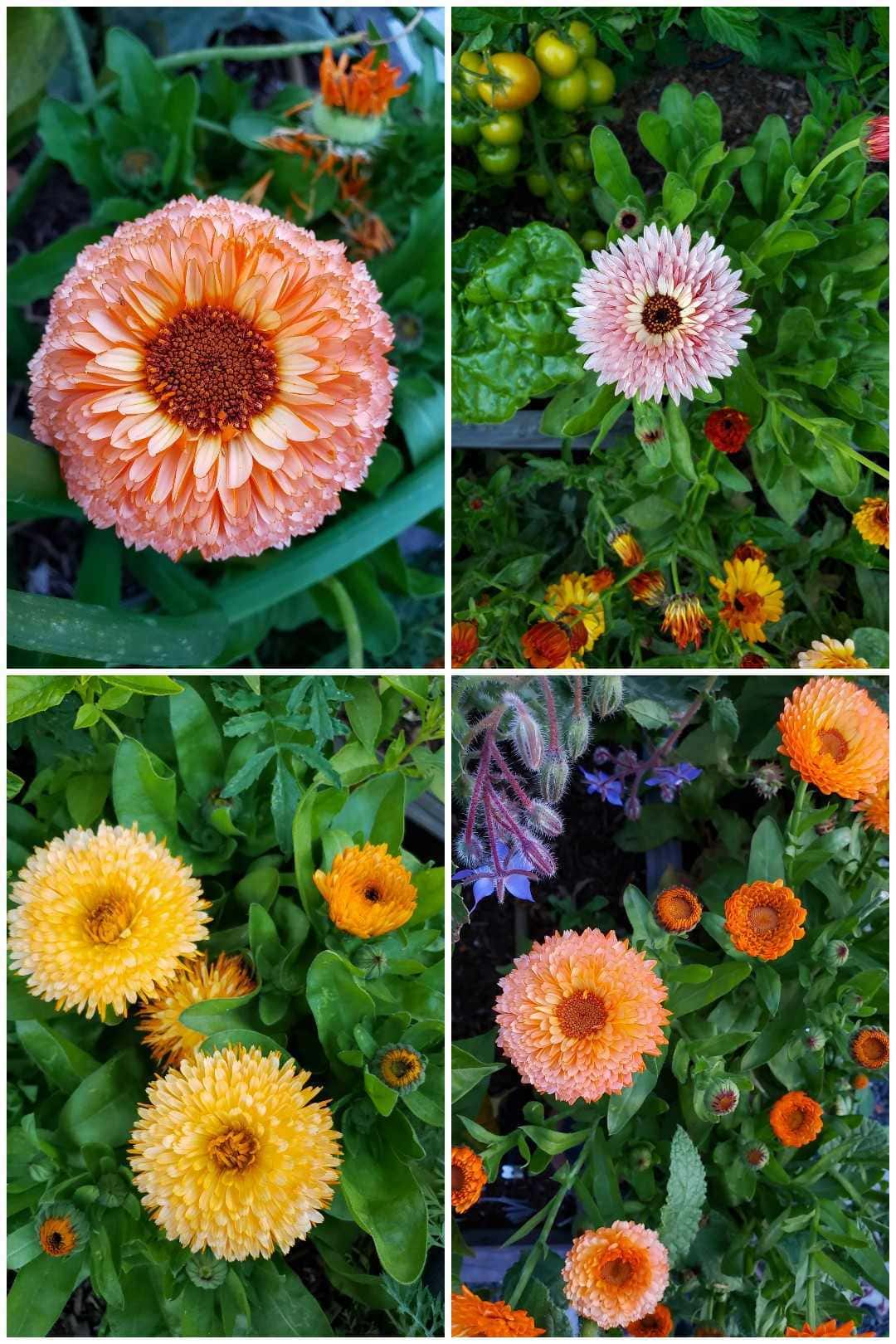
So, are you convinced? Are you ready to try to grow calendula in your home garden? I shouldn’t even say “try” – because there’s really not much to it! I’d like to wager that even the blackest of thumbs out there can successfully grow calendula.
How to Grow Calendula
Calendula is just about as no-fuss and low-maintenance as they come. It will perform best in rich, well-draining soil, but will tolerate a wide variety of soils – including poor soil. Heck, half of ours this year isn’t even growing in soil. Spent blooms dropped seed into the gravel area around our raised beds (that has landscape fabric below it) and they’re growing very happily there (pictured below). It is also very easy to successfully grow calendula in containers as well.
You can either grow calendula seeds indoors and transplant seedlings outside, or direct-sow calendula seeds in the garden in spring after the last frost. Follow the instructions on the seed package in regards to depth (usually around 1/4″ deep). Thin seedlings early to prevent overcrowding, spacing plants about 8 to 12 inches apart.
Calendula grows best in full-sun, but will tolerate some late afternoon shade, especially in the hottest climates. Provide moderate water. It won’t like being overly wet, as it is fairly drought-tolerant. Calendula is tolerant to both heat and cold. The plants and long-lasting blooms may continue straight through the first freeze the following winter! It is also reported to be deer-resistant.
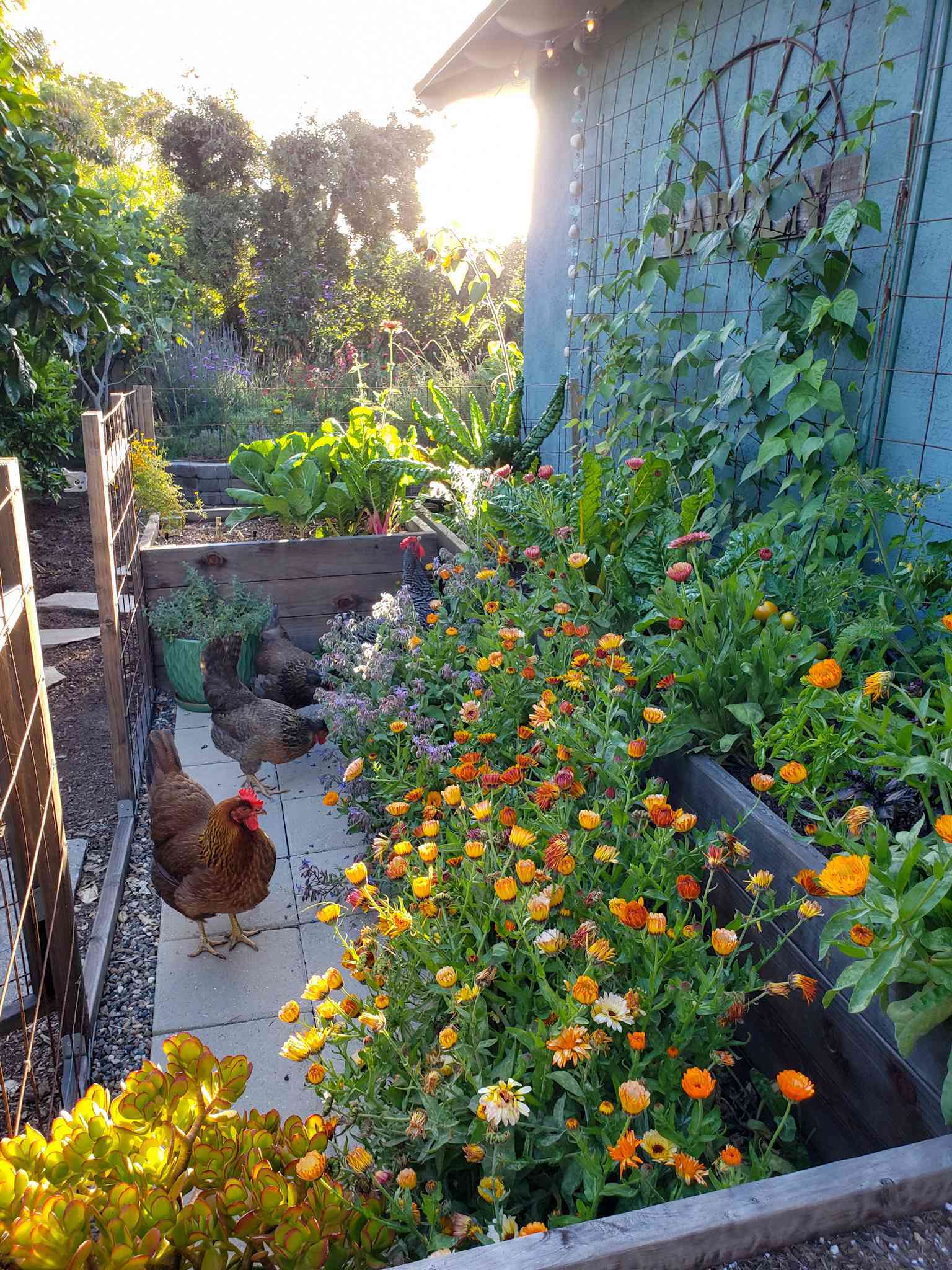
Calendula disease and pests
Calendula does not attract many pests. The one disease that seems most likely to affect this plant is powdery mildew, which unfortunately is very common here. Avoid overcrowding plants to increase airflow and reduce the chances of disease. Thankfully, the mildew only seems to affect the foliage and not the blooms. Learn how to prevent and treat powdery mildew organically here.
When to Harvest Calendula
Herbalist all agree that the best time to harvest calendula is during mid-morning, shortly after the new blooms have opened but after any dew has dried. That said, simply do your best given your schedule. Harvesting midday or even in the afternoon is better than not harvesting them at all!
If you plan to use it for edible or medicinal purposes, harvest calendula flowers when they’re fresh, young, and have just fully opened. Avoid collecting heads that are already starting to dry and form seeds. You can leave those on the plant to fully dry and mature for seed-saving instead.
On that note, uncollected flower heads will allow calendula to freely re-seed itself. If you don’t want your garden full of calendula volunteers, plan to collect spent flowers before the seeds dry and disperse. We harvest some, but leave plenty behind as well. The volunteers are welcome here!
How to Harvest Calendula
To harvest calendula blooms, simply pick or cut off the flower where it meets the stem. Yes, take the whole head! The most medicinal value is actually found in the green pedestal, not just the flower petals. While harvesting calendula, your fingers may get a bit sticky from the resin. This is a good thing! In fact, the stickier the better. The resin has potent antifungal properties and is where most of the healing power comes from.
Don’t be shy about harvesting calendula flowers. The more you harvest, the more will grow. If you’re serious about stocking up on calendula, plan harvest new blooms every few days.
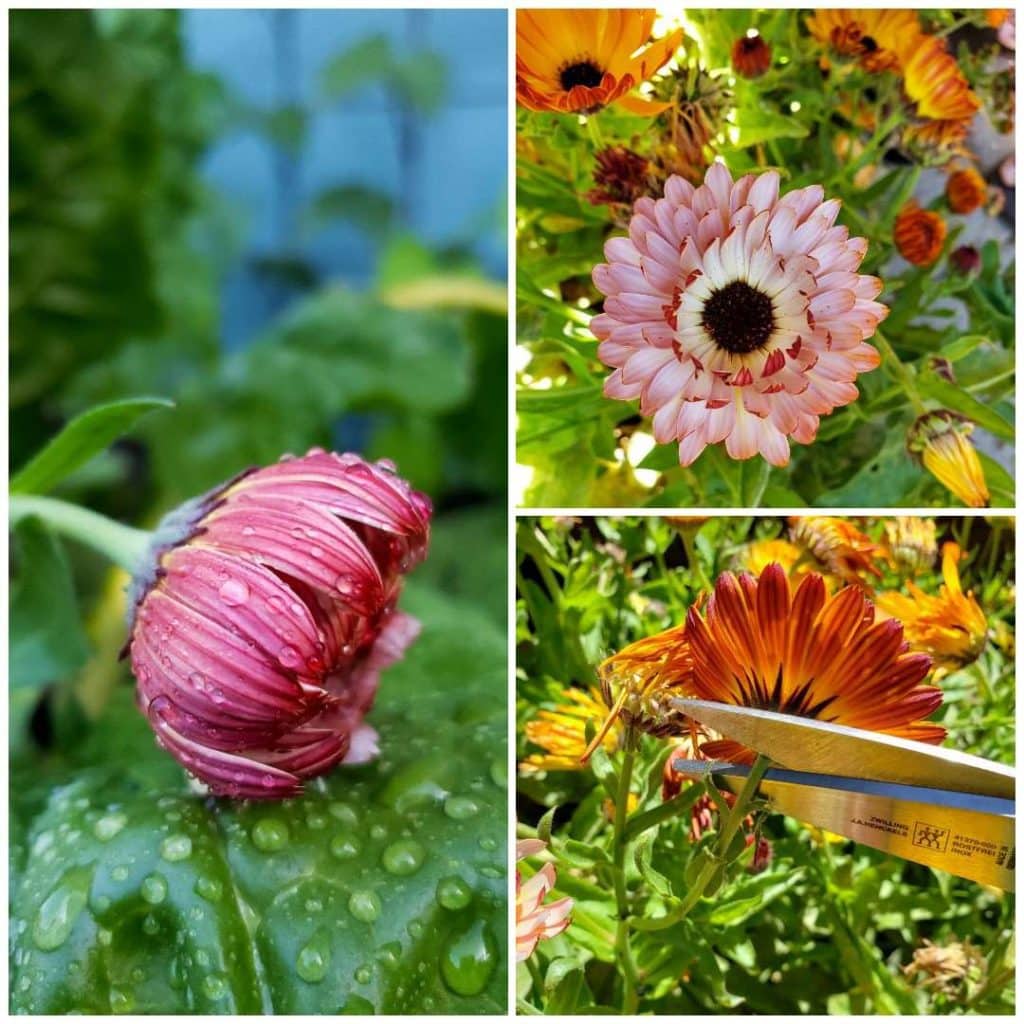
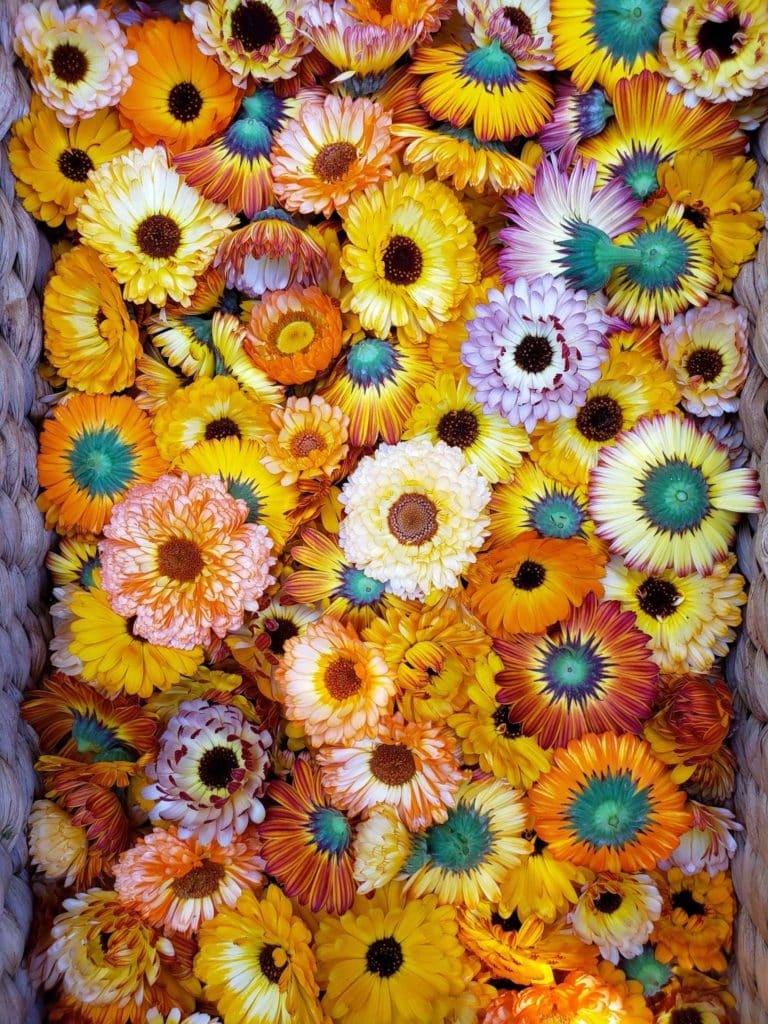
How to Dry & Store Calendula
There are a variety of ways to dry calendula. No matter how you do it, one thing is of the utmost importance: make sure that it is 100% completely dry before being put away for storage. I have heard too many horror stories of jars full of moldy blooms, after all that hard work to collect and preserve them. So, so sad! The next very important thing to note is that calendula should not be exposed to high temperatures when drying. Heat will denature and ruin much of its medicinal components. Therefore, drying in an oven is not recommended.
You can choose to dry the petals, or the entire head. Petals alone will dry more quickly and have less chance of mold. However, plucking petals takes a lot more upfront labor to prepare for drying. Not to mention, the green base of the flower is incredibly resinous and potentially holds even more beneficial compounds than the petals, so we dry the blooms whole.
Do not wash blooms before drying. If needed, gently shake them out to dislodge dust or occasional insects. But since we are taking newly-opened blooms, they should be fresh as daisies!
Air Drying Calendula
Under the right conditions, calendula can passively air dry. It just takes a bit of time and patience. Okay, maybe a lot of time. In a warm, well-ventilated, dry location, set the calendula blooms on screens, in airy baskets, or other breathable racks, like this hanging herb drying rack, which we use for another kind of herb. 😉 Periodically toss and turn the blooms to ensure they’re drying evenly. Then wait.
Given our temperate climate, humidity, and cool spring weather, we decided to not fuss with air drying. It would take forever, and I was worried they would mold. Instead, we used our food dehydrator.

Drying Calendula in a Food Dehydrator
This method will get the job done much faster! But remember, we don’t want to heat the calendula. Set your dehydrator on the lowest setting – no warmer than 95-100°F. Our awesome Excalibur dehydrator has a “living foods” setting in this range, which ensures all the beneficial healing properties of herbs or other plants aren’t destroyed by heat!
Lay out your calendula blooms face down on your dehydrator racks. On a low setting, dry them until they’re dry. Bone dry. Sorry, there isn’t an exact time to go by!
The time it takes to fully dry depends on the method you use, your machine (or not), if you’re drying petals only or whole heads, and the flowers themselves. For example, some of our smallest blooms were completely dry within a day or two, while the fattest, largest heads still seemed like they needed a few more days.
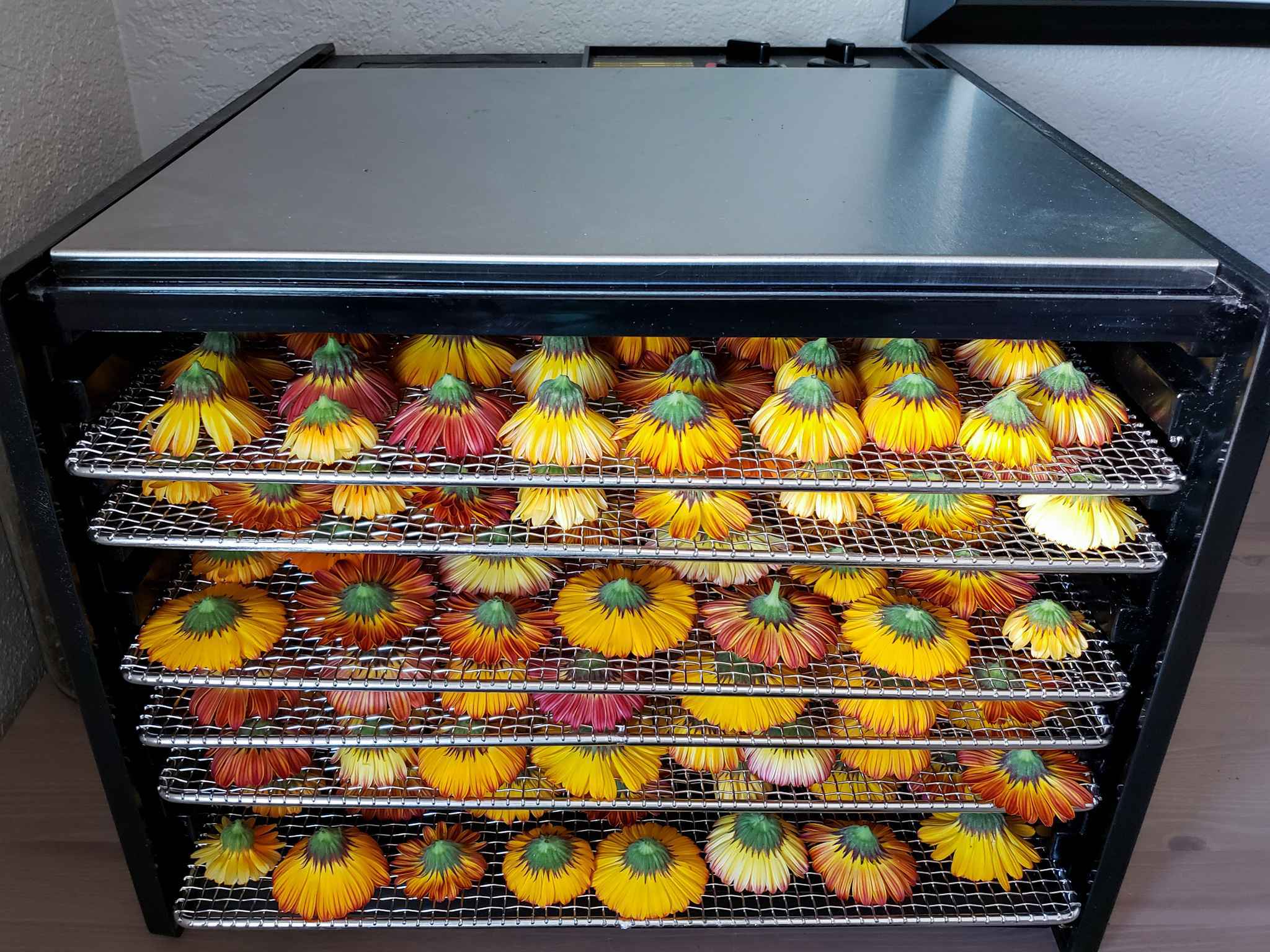

Store dried calendula blooms in an airtight container out of direct sunlight, and use within one year.
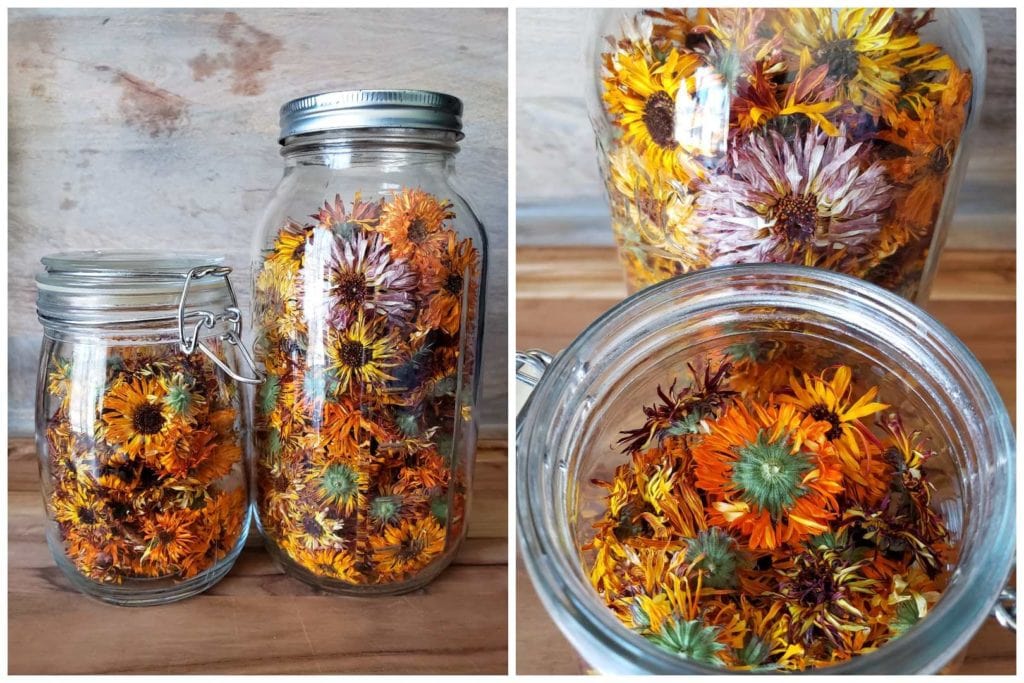
How to Use Dried Calendula
So, what do I do with all this dried calendula? Well… any number of things!
Calendula Tea
For internal use, one of the quickest and easiest ways to prepare dry calendula is making a tea infusion. In 8 ounces of water, steep approximately 1 to 3 loose Tablespoons of dried petals, or 4 to 6 dried flower heads. This is easy to do with the assistance of a loose-leaf tea infuser, like this one we love and use. Cover and steep in hot water for 8 to 10 minutes, and then enjoy! Or, scale up the portions and steep a larger pot to enjoy over a couple of days. It is best to store the prepared tea in the refrigerator to maintain freshness.
Keep in mind that people make medicinal teas primarily for their health benefits over pure enjoyment and flavor. Thankfully, I quite like the taste of calendula tea! It is mellow, slightly earthy, slightly sweet, and maybe just a tad bit grassy – but not nearly as grassy as over-steeped green tea.
Enjoy calendula tea on occasion to boost your mood. After all, it is historically referenced for having antidepressant properties! Or, if you are in need of some deeper healing (and have an ample supply!), feel free to sip on the tea up to three times a day. You really can’t overdo it. Calendula has no limit or risk of toxicity! I have been sipping calendula tea this spring to ease my swollen lymph glands caused by allergies.
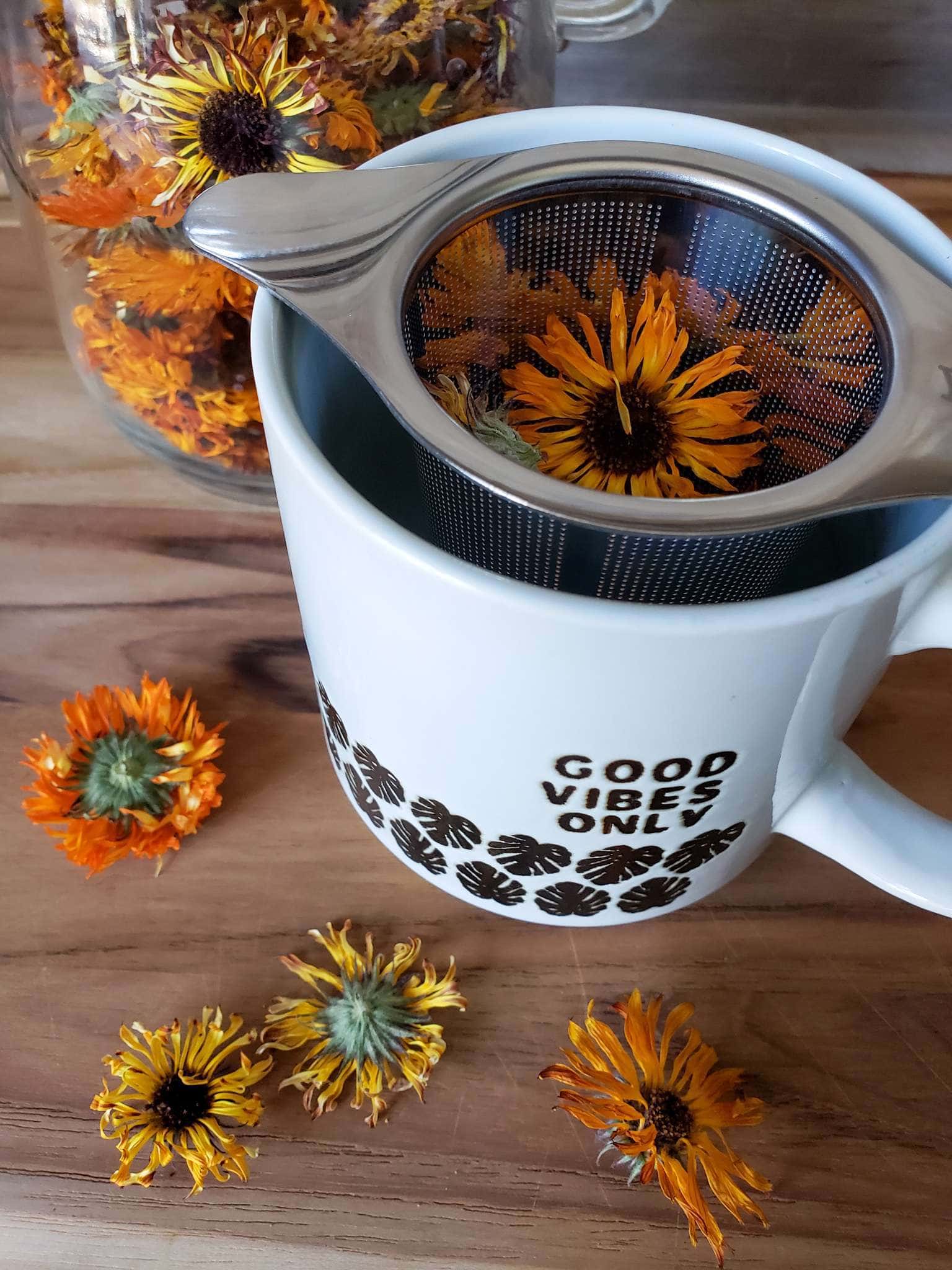
Other Ways to Use Dried Calendula
In addition to adding it to various meals and beverages, herbalists use dried calendula to make incredibly healing calendula-infused oil, topical salves and creams, or tinctures for internal use. When applied topically, calendula can help ease inflammation, redness, rashes or other irritation, eczema, psoriasis, and more.
Learn how to make homemade calendula oil here, along with 8 ways to use it! Then, you could turn your oil into incredibly moisturizing homemade calendula salve with this tutorial. We also offer organic calendula salve in our shop, made with flowers grown in our home garden.
If you have chickens, calendula petals can be added to their nesting boxes as a natural insect repellent. Also, if you feed your chickens fresh or dried calendula petals, their egg yolks will be even more golden orange! Plus, they’ll reap all the health benefits as well. You can also add petals or whole flowers to a bubble bath!
If you want to dive deeper, I highly recommend checking out the book “Medicinal Herbs: A Beginner’s Guide” by Rosemary Gladstar. It has been one of my key sources of information and inspiration thus far – for calendula, and beyond! Another great resource is this Organic Body Care Recipes book.
Now you know all about calendula!
I hope you found this article to be interesting and helpful as you start your calendula journey. Even if you don’t plan to get all deep into salves and oils, you won’t regret adding it to your garden. I promise!
Finally, let me know if you have any questions, and please spread the love and share this post with friends!





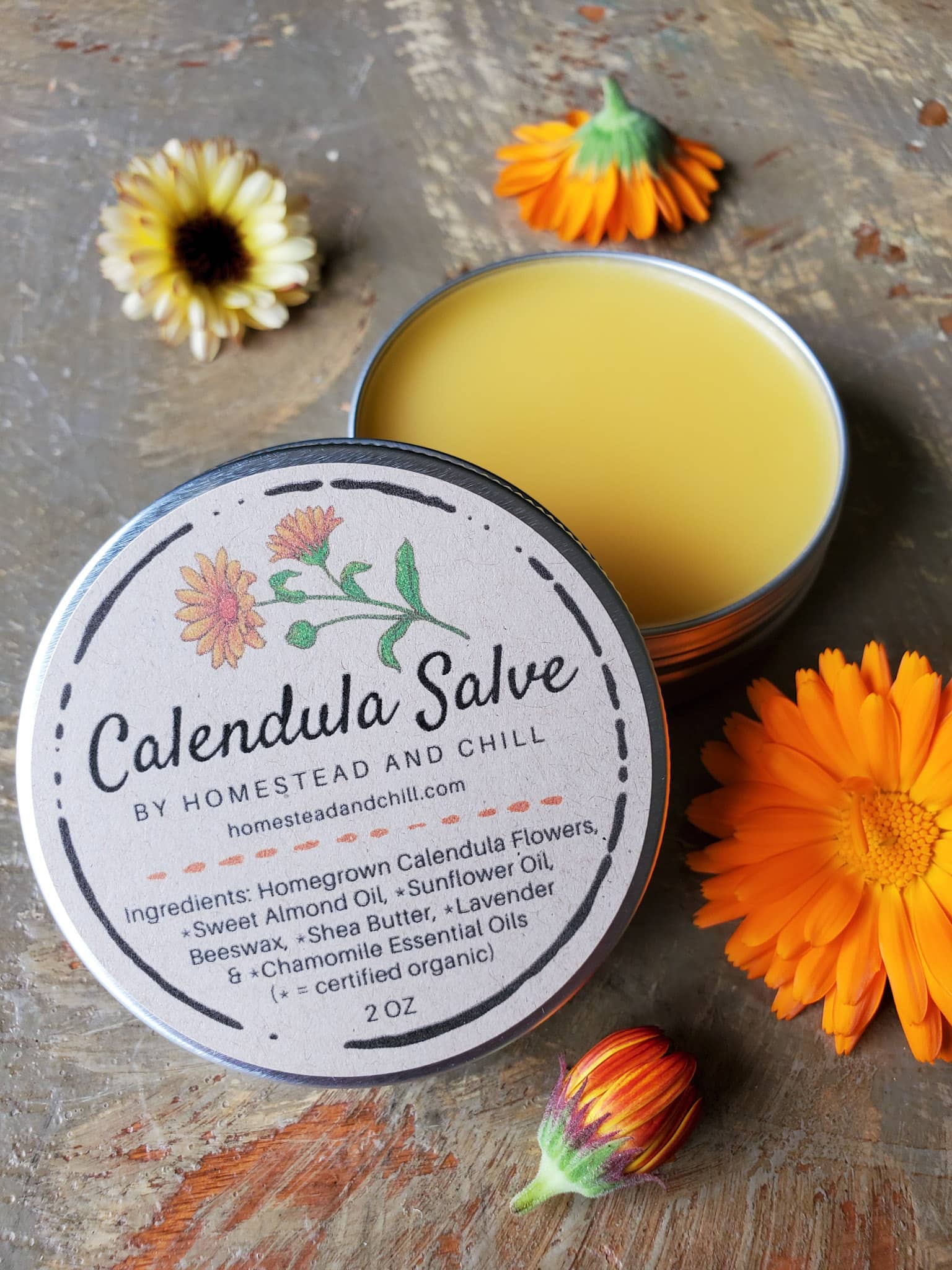



97 Comments
Linda Bisson
Good Morning Deanna and Aaron…I reread this post after some of the calendula flowers that I dried have gone mouldy in the jar that I stored them in, and others feel soft to the touch (rather than dry and papery as they were when I retrieved them from my dehydrator). I am concerned that they all may turn mouldy…even though they have dried for more than 2 days. Some batches were infused immediately, so I am hoping the resulting oil is ok. Any additional ideas would be appreciated. I will dry for a longer period…usually at 98 degrees, from here on.
Aaron (Mr. DeannaCat)
Hi Linda, that’s too bad to hear about the calendula flowers molding on you, it’s hard to say about the calendula flowers in the oil (all you can do at this point is wait and see if it spoils or not) but for the flowers that have been dried already that aren’t yet moldy, I would try and lay the flowers out at room temperature or put them back into the dehydrator for awhile. We typically dry our calendula flowers for at least 72 hours at 98-100 degrees F as we like to err on the side of caution over having the flowers molding either in their storage jar or in the oil itself. Hope that helps and good luck on making your calendula oil and getting a surplus of dried calendula flowers!
TC
I have a question–if I want more blooms should I cut my long and leggy calendula and where? TIA
Aaron (Mr. DeannaCat)
Hi TC, our calendula plants will continue to grow and get taller but we don’t really trim them back all that much. Just keep up with picking the flowers more frequently and the plants will continue to bloom, as the plant gets older, the flowers will reduce in size and the plant will start to slow down in the amount of flowers it produces and no amount of pruning or cutting back will reverse that. Hope that helps and have fun growing!
Angela
Thanks for the post and all the great info you provide. I cut off my first flowers and noticed a bunch of tiny little bugs inside. They were everywhere in a matter of seconds so I put them back outside. Very very tiny long brownish insects. Any idea what they could be? I’ve gotten so many bites while doing minimal gardening so I’m hesitant to keep them inside!
Aaron (Mr. DeannaCat)
Hi Angela, I wouldn’t be too worried about the insects biting you so you can likely still bring the flowers indoors for drying (will you be using a food dehydrator to expedite the process?). If you want the bugs to “jump ship” off of the flowers before you bring them indoors, you can likely leave them outside for several hours and the insects should leave the flowers as they sense that they are no longer alive. Hope that helps and good luck!
Lana
Hi Angela, we have those too. They are a little bug called a Thrip. As far as I am aware, they’re not harmful. I typically leave the calendula blossoms in a colander on a table outside for a few hours after harvesting and shake every so often to get as many of them out as we can.